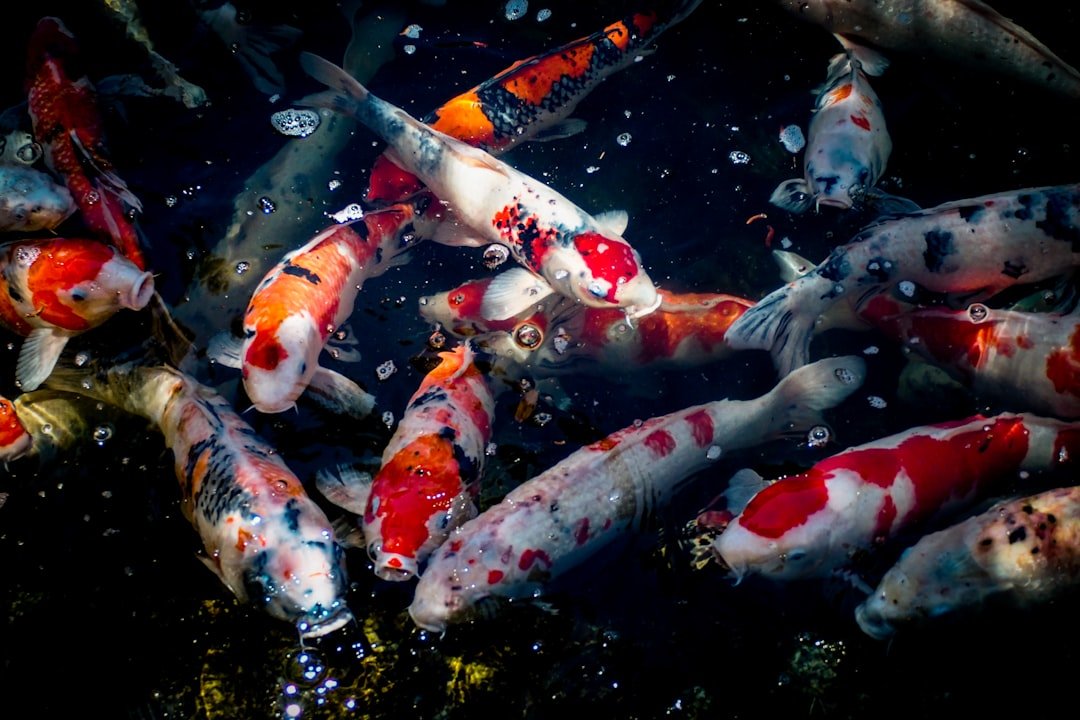Sleep is a universal phenomenon that is observed in almost all animals, including fish. While it may seem surprising that fish sleep, they do indeed have periods of rest and inactivity that are similar to sleep in other animals. Studying fish sleep is important not only for understanding the sleep patterns and behaviors of these aquatic creatures, but also for gaining insights into the evolution and function of sleep in general.
Fish are a diverse group of animals that inhabit a wide range of aquatic environments, from freshwater lakes and rivers to the depths of the ocean. They come in various shapes and sizes, with different physiological adaptations to their respective habitats. Despite these differences, fish share some common characteristics when it comes to sleep. By studying their sleep patterns and behaviors, scientists can gain a better understanding of the fundamental aspects of sleep and its role in animal physiology.
Key Takeaways
- Fish sleep, just like humans and other animals.
- Fish have different types of sleep, including active and resting states.
- Fish sleep is influenced by environmental factors such as light, temperature, and oxygen levels.
- Fish can sleep alone or in groups, and their social dynamics affect their resting habits.
- Studying fish sleep can provide insights into the importance of sleep for all animals.
The Definition of Sleep: What Does it Mean for Fish?
Sleep is a complex physiological state characterized by reduced consciousness, decreased responsiveness to external stimuli, and changes in brain activity and behavior. It is a vital process that is essential for maintaining overall health and well-being. While sleep has been extensively studied in mammals and birds, research on fish sleep is relatively new.
In fish, sleep is defined as a period of reduced activity and responsiveness that is accompanied by changes in brain activity. Like other animals, fish exhibit distinct sleep states that can be classified as either active or resting sleep. Active sleep, also known as REM (rapid eye movement) sleep, is characterized by rapid eye movements, increased brain activity, and muscle paralysis. Resting sleep, on the other hand, is a state of reduced brain activity and decreased responsiveness to external stimuli.
The Different Types of Fish Sleep: Active vs. Resting States
Fish exhibit both active and resting states during their sleep cycles. Active sleep is characterized by rapid eye movements, increased brain activity, and muscle paralysis. This state is similar to REM sleep in mammals and birds. Resting sleep, on the other hand, is a period of reduced brain activity and decreased responsiveness to external stimuli. During resting sleep, fish may exhibit slow swimming or remain motionless.
The differences between active and resting sleep in fish are not yet fully understood. However, it is believed that these two states serve different functions. Active sleep may be involved in memory consolidation and learning, while resting sleep may be important for energy conservation and tissue repair. Further research is needed to fully understand the functions and mechanisms of these sleep states in fish.
How Do Fish Sleep? Understanding the Physiology of Fish Rest
| Metrics | Description |
|---|---|
| Sleep duration | Varies depending on the species, ranging from a few minutes to several hours per day |
| Sleep patterns | Some fish sleep continuously, while others sleep in short bursts throughout the day and night |
| Brain activity | Fish exhibit different patterns of brain activity during sleep compared to wakefulness |
| Resting position | Fish may rest on the bottom of the tank, in plants, or even in mid-water |
| Environmental factors | Water temperature, light, and other environmental factors can affect fish sleep patterns |
During sleep, fish undergo various physiological changes that are similar to those observed in other animals. Brain activity during sleep is different from that during wakefulness, with specific patterns of electrical activity that can be measured using electroencephalography (EEG). In fish, these sleep-related brain patterns have been observed in several species, including zebrafish and goldfish.
In addition to changes in brain activity, fish also exhibit changes in behavior and physiology during sleep. For example, their heart rate and respiration rate may decrease, and their metabolism may slow down. Some fish may also change their body position or seek out sheltered areas during sleep. These changes in behavior and physiology are thought to be adaptive responses that help fish conserve energy and protect themselves from predators while they are asleep.
Sleep cycles in fish can vary depending on the species and environmental conditions. Some fish may have short sleep cycles of just a few minutes, while others may have longer sleep cycles that last for several hours. The duration and frequency of sleep cycles can also be influenced by factors such as temperature, light levels, and social interactions. Understanding the sleep cycles of different fish species can provide valuable insights into the physiological adaptations and behaviors associated with sleep.
The Importance of Sleep for Fish: Why Do They Need It?
Sleep is a fundamental biological process that is essential for the health and well-being of all animals, including fish. It serves a variety of important functions that are crucial for survival and reproduction. One of the main benefits of sleep is its role in memory consolidation and learning. During sleep, the brain processes and consolidates information that has been acquired during wakefulness, which helps to improve cognitive function and enhance learning and memory.
Sleep also plays a vital role in maintaining overall physical health. It is during sleep that the body repairs and regenerates tissues, strengthens the immune system, and balances hormone levels. Sleep deprivation can have serious consequences for fish, including impaired cognitive function, decreased immune function, and increased susceptibility to disease. In extreme cases, sleep deprivation can even lead to death.
From an evolutionary perspective, sleep is thought to have originated as a way to conserve energy and reduce exposure to predators during periods of inactivity. By entering a state of reduced consciousness and decreased responsiveness, animals can minimize their energy expenditure and increase their chances of survival. Sleep also allows animals to allocate resources more efficiently, by prioritizing essential physiological processes such as tissue repair and immune function.
The Role of Light and Darkness in Fish Sleep Patterns

Light and darkness play a crucial role in regulating sleep patterns in fish. Like other animals, fish have internal biological clocks that help to regulate their sleep-wake cycles. These biological clocks are influenced by environmental cues such as light and darkness, which help to synchronize the timing of sleep and wakefulness with the natural day-night cycle.
Circadian rhythms are internal biological rhythms that follow a 24-hour cycle. They are regulated by a group of cells in the brain called the suprachiasmatic nucleus (SCN), which acts as the body’s master clock. Light is the primary cue that synchronizes the SCN with the external environment. When light levels are high, the SCN signals the body to be awake and active. When light levels are low, the SCN signals the body to enter a state of rest and sleep.
The effects of light and darkness on fish sleep patterns can vary depending on the species and their natural habitats. Some fish are diurnal, meaning they are active during the day and sleep at night. Others are nocturnal, meaning they are active at night and sleep during the day. Some fish may also exhibit crepuscular behavior, being most active during dawn and dusk. These adaptations to different light conditions help fish optimize their foraging and reproductive activities.
Environmental Factors that Affect Fish Sleep: Temperature, Oxygen Levels, and More
In addition to light and darkness, there are several other environmental factors that can affect fish sleep patterns. Temperature is one such factor that can have a significant impact on sleep. Fish are ectothermic animals, meaning their body temperature is regulated by their environment. As a result, changes in temperature can influence their metabolic rate and overall activity levels.
Research has shown that fish tend to sleep less when water temperatures are higher, as higher temperatures increase their metabolic rate and energy expenditure. Conversely, fish may sleep more when water temperatures are lower, as lower temperatures decrease their metabolic rate and energy expenditure. These temperature-dependent changes in sleep patterns help fish conserve energy and adapt to different environmental conditions.
Oxygen levels in the water can also affect fish sleep patterns. Fish rely on dissolved oxygen in the water for respiration, and low oxygen levels can have detrimental effects on their health and well-being. When oxygen levels are low, fish may exhibit shallow or intermittent sleep patterns in order to conserve energy and minimize their oxygen requirements.
Other environmental factors that can affect fish sleep include water quality, noise levels, and predation risk. Poor water quality can disrupt sleep patterns by causing stress or discomfort to fish. Noise pollution from human activities can also disturb fish sleep, as fish are sensitive to changes in sound levels. Finally, the presence of predators can influence sleep behavior by increasing vigilance and reducing the amount of time spent in deep sleep.
Sleeping Alone or in Groups? The Social Dynamics of Fish Resting Habits
Fish exhibit a wide range of sleeping behaviors, including both solitary and group sleeping. Some fish prefer to sleep alone, seeking out secluded areas or hiding in crevices or vegetation. This solitary sleeping behavior allows them to minimize their exposure to predators and reduce the risk of competition for resources.
On the other hand, many fish species exhibit group sleeping behavior, where individuals sleep in close proximity to each other. Group sleeping can provide several benefits, including increased protection against predators, improved foraging efficiency, and enhanced social bonding. By sleeping in groups, fish can take turns being on guard and alert for potential threats, while others rest and conserve energy.
The benefits of group sleeping can vary depending on the species and their natural habitats. For example, some fish form tight schools during sleep to create a collective defense against predators. Others may form loose aggregations or sleep in pairs to maintain social bonds and facilitate reproductive activities. The specific sleeping behaviors of fish are influenced by factors such as predation risk, resource availability, and social dynamics within the group.
Do All Fish Sleep? Exploring the Sleeping Habits of Different Fish Species
While most fish do exhibit periods of rest and inactivity that are similar to sleep, not all fish sleep in the same way. Different species of fish have different sleeping habits and patterns that are influenced by their natural habitats and ecological niches. Some fish may have short sleep cycles that last only a few minutes, while others may have longer sleep cycles that last several hours.
The sleeping habits of fish can also vary depending on their physiological adaptations and behaviors. For example, some fish have specialized structures such as gills or lungs that allow them to extract oxygen from the water or air, respectively. These fish may exhibit different sleep patterns and behaviors compared to fish that rely solely on gills for respiration.
Some fish species have also been observed to exhibit unusual sleeping behaviors. For example, some species of parrotfish create a mucus cocoon around their bodies before going to sleep. This cocoon acts as a protective barrier against predators and helps to reduce the risk of infection or injury during sleep. Other fish, such as certain species of wrasses, bury themselves in the sand or mud during sleep to hide from predators and conserve energy.
What We Can Learn from the Sleeping Habits of Fish
Studying the sleeping habits of fish provides valuable insights into the fundamental aspects of sleep and its role in animal physiology. By understanding how fish sleep, scientists can gain a better understanding of the functions and mechanisms of sleep in general. This knowledge can then be applied to other animals, including humans, to improve our understanding of sleep disorders and develop new treatments.
The sleeping habits of fish also highlight the importance of environmental factors in regulating sleep patterns. Fish have evolved various adaptations to different light conditions, temperature ranges, and oxygen levels in their natural habitats. By studying these adaptations, scientists can gain insights into how environmental factors influence sleep in other animals, including humans.
Future research directions in fish sleep include investigating the molecular and genetic mechanisms that regulate sleep in different species. By identifying the genes and proteins involved in sleep regulation, scientists can gain a better understanding of the underlying mechanisms and pathways that control sleep. This knowledge could then be used to develop new therapies for sleep disorders and improve overall sleep health in humans and other animals.
In conclusion, the study of fish sleep is a fascinating field that offers valuable insights into the fundamental aspects of sleep and its role in animal physiology. By understanding how fish sleep, scientists can gain a better understanding of the functions and mechanisms of sleep in general. This knowledge can then be applied to other animals, including humans, to improve our understanding of sleep disorders and develop new treatments. The sleeping habits of fish also highlight the importance of environmental factors in regulating sleep patterns. Future research directions in fish sleep include investigating the molecular and genetic mechanisms that regulate sleep in different species.
If you’re fascinated by the mysteries of the underwater world, you might be curious about whether fish can sleep. Well, according to a fascinating article on Just Tidings, scientists have discovered that fish do indeed sleep, but in a very different way than humans. To learn more about this intriguing topic, check out the article “Can Fish Sleep? Unraveling the Secrets of Underwater Slumber” at Just Tidings.




















+ There are no comments
Add yours